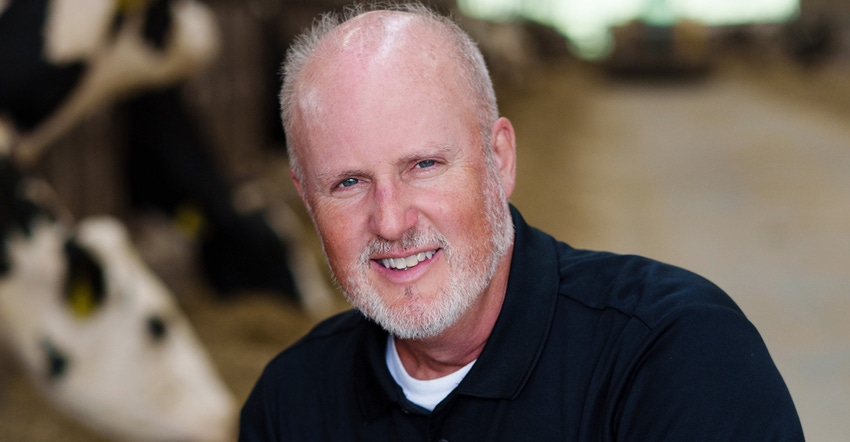
John Chrisman remembers the days when getting a “Got Milk” logo in the local newspaper was a big deal for dairy farmers.
Print is still alive, of course, and there is still value in getting an ad in the newspaper or magazine, but people are moving to smartphones and computers like never before — and it’s a place Chrisman says dairy doesn’t want to be left behind.
“In the old days, it was all about print advertising, but now we've got to meet consumers in their digital space to not only display the benefits of dairy and what dairy has to offer, but also introduce them to our farmers," says Chrisman, who officially took over leadership of the American Dairy Association on June 2, replacing the now-retired Rick Naczi.
Chrisman has been with the dairy checkoff since 2001, first with American Dairy Association Mideast, then with Mid-Atlantic Dairy Association and the Pennsylvania Dairy Promotion Program. The latter two merged in 2016 to form American Dairy Association Northeast, which now covers five states — Delaware, Maryland, New Jersey, New York and Pennsylvania — and parts of northern Virginia.
The checkoff-funded association develops and implements local programs to drive milk and dairy sales at retail outlets and schools.
Before joining the dairy checkoff, Chrisman held jobs with Campbell’s Soup and Hanover Foods.
All about fluid
While yogurt is a big outlet for milk in some places, especially New York, driving fluid milk sales is still the priority for dairy farmers, Chrisman says.
“We’ve always and will continue to promote fluid milk, and we’ve seen some growth more recently in the value-added section such as lactose free,” he says, adding that whole milk sales have been growing for the past 10 years and now make up about 42% of total fluid sales at retail.
Flavored milk is also seeing significant growth, Chrisman says. A program the association started, “Refuel with Chocolate Milk,” targets coaches and athletic directors at local colleges and high schools with the message of getting student-athletes to drink chocolate milk to recover from competition.
“That message has really taken off and gives us the opportunity to educate athletic directors and coaches, so that’s been a really good program for us as well,” he says.
Chrisman has been on the job for less than a month, but he’s already targeted a few areas — silos, as he calls them — where he hopes to make the biggest impact, at least initially: utilizing staff strengths; growing programs that return the best bang for dairy farmers’ money; and increasing consumer outreach.
The third silo presents the most opportunity, but it is also changing quickly.
“We’re doing a lot more account-specific programming, regally targeting Gen Z,” Chrisman says. “They’re such a huge audience for us, currently, so we’re really evolving as consumers change.”
“When you have less than 2% of the population in this country having anything to do with agriculture, people don't know where their dairy comes from,” he adds. “So now, more than ever, people want to know where their milk is coming from, and this is an opportunity to introduce consumers to dairy farmers.”
Gone digital
Chrisman says the pandemic, in part, forced the association to quickly adapt to digital programming as people were kept apart and children stayed home from school.
“We adjusted our marketing to reach more consumers in that digital space with programs like virtual farm tours,” he says.
Last year, virtual farm tours, where a farmer can remotely welcome students to their farm, reached 60,000 students across the region, Chrisman says. By contrast, the average-sized dairy farm, he says, would have to do 200 live tours or more in a year to reach that many students.
Another program, “This American Dairy Farmer” on YouTube, has reached thousands more people.
Chrisman says that establishing these connections with consumers is important, as is “contemporizing the dairy aisle” in some grocery stores with photos of farms displayed next to milk and other dairy products.
Processor innovations
Of course, dairy farmers are only part of the supply chain that gets milk from cows to stores. Processors are an important part of that supply chain, and Chrisman says they are developing more innovative ways to package and sell milk like never before.
For example, consumers can now find Fruit Loops Milk, which was developed by Nestle and is supposed to taste like the leftover milk from a bowl of Fruit Loops, in many stores — along with Cinnamon Toast Crunch milk.
Another example is western Pennsylvania-based Turner Dairy forming a partnership with Eat’n Park, a popular regional restaurant chain, to develop a smiley cookie milk named after the restaurant’s popular smiley cookies.
Turner has also launched flavored cottage cheese in six varieties.
“Just a lot of innovation and education, and to be honest with you, we're going to have to continue that or we're going to get passed by competitors, such as coffee and even water, and alternative beverages," Chrisman says. “We just have to keep evolving as consumers change.”
Communicating with farmers
But it’s not just consumers that the association needs to communicate with. Dairy farmers, who pay for the checkoff by contributing a 15-cent assessment on all produced and marketed milk — most of that going to regional checkoffs like American Dairy Association Northeast — also need to be kept in the loop of what the checkoff is doing, and that’s also changed, Chrisman says.
District meetings with local farmers are still the norm, but he says the association has shifted much of its communication to digital.
And just like consumers, Chrisman says the association also deals with misconceptions of how dairy farmers’ money is being used. This has become more challenging, he says, as farmers get their information from many sources, particular over the internet. But he welcomes the challenge.
“We've got a really good staff with a lot of levels of expertise,” he says. “Before I applied for the position, I asked myself those questions: Do we have staff? Do we have the right skill sets to keep moving forward? Fortunately, I was able to answer myself yes.”
About the Author(s)
You May Also Like






